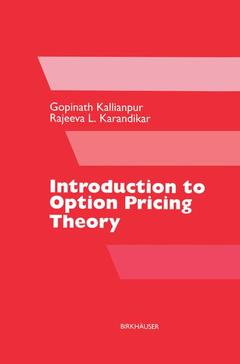Description
Introduction to Option Pricing Theory, Softcover reprint of the original 1st ed. 2000
Authors: Kallianpur Gopinath, Karandikar Rajeeva L.
Language: English
Subjects for Introduction to Option Pricing Theory:
116.04 €
In Print (Delivery period: 15 days).
Add to cart
Introduction to Option Pricing Theory
Publication date: 10-2012
269 p. · 15.5x23.5 cm · Paperback
Publication date: 10-2012
269 p. · 15.5x23.5 cm · Paperback
105.49 €
Subject to availability at the publisher.
Add to cart
Introduction to Option Pricing Theory
Publication date: 10-1999
269 p. · 15.5x23.5 cm · Hardback
Publication date: 10-1999
269 p. · 15.5x23.5 cm · Hardback
Description
/li>Contents
/li>
Since the appearance of seminal works by R. Merton, and F. Black and M. Scholes, stochastic processes have assumed an increasingly important role in the development of the mathematical theory of finance. This work examines, in some detail, that part of stochastic finance pertaining to option pricing theory. Thus the exposition is confined to areas of stochastic finance that are relevant to the theory, omitting such topics as futures and term-structure. This self-contained work begins with five introductory chapters on stochastic analysis, making it accessible to readers with little or no prior knowledge of stochastic processes or stochastic analysis. These chapters cover the essentials of Ito's theory of stochastic integration, integration with respect to semimartingales, Girsanov's Theorem, and a brief introduction to stochastic differential equations. Subsequent chapters treat more specialized topics, including option pricing in discrete time, continuous time trading, arbitrage, complete markets, European options (Black and Scholes Theory), American options, Russian options, discrete approximations, and asset pricing with stochastic volatility. In several chapters, new results are presented. A unique feature of the book is its emphasis on arbitrage, in particular, the relationship between arbitrage and equivalent martingale measures (EMM), and the derivation of necessary and sufficient conditions for no arbitrage (NA). {\it Introduction to Option Pricing Theory} is intended for students and researchers in statistics, applied mathematics, business, or economics, who have a background in measure theory and have completed probability theory at the intermediate level. The work lends itself to self-study, as well as to a one-semester course at the graduate level.
1 Stochastic Integration.- 1.1 Notation and definitions.- 1.2 The predictable ? field.- 1.3 The Itô integral.- 1.4 Quadratic variation of a continuous martingale.- 1.5 The stochastic integral w.r.t. continuous local martingales.- 1.6 Stochastic integral w.r.t. continuous semimartingales.- 1.7 Integration w.r.t. semimartingales.- 2 Itô’s Formula and its Applications.- 2.1 Preliminaries.- 2.2 Itô’s formula for continuous semimartingales.- 2.3 Itô’s formula for r.c.l.l. semimartingales.- 2.4 Applications.- 2.5 Application to geometric Brownian motion.- 2.6 Local time and the Tanaka formula.- 2.7 Brownian motion and the heat equation.- 3 Representation of Square Integrable Martingales.- 3.1 The Itô representation.- 3.2 The Kunita-Watanabe representation.- 4 Stochastic Differential Equations.- 4.1 Preliminaries.- 4.2 Existence and uniqueness of solutions.- 4.3 The Feynman-Kac formula.- 4.4 The Ornstein-Uhlenbeck process (O.U.P).- 5 Girsanov’s Theorem.- 5.1 Auxiliary results.- 5.2 Girsanov’s Theorem.- 6 Option Pricing in Discrete Time.- 6.1 Arbitrage opportunities.- 6.2 Option pricing: an example.- 6.3 European call option.- 6.4 Complete markets.- 6.5 The American option.- 7 Introduction to Continuous Time Trading.- 7.1 Introduction.- 7.2 A general model.- 7.3 Trading strategies and arbitrage opportunities.- 7.4 Examples.- 7.5 Contingent claims and complete markets.- 8 Arbitrage and Equivalent Martingale Measures.- 8.1 Introduction.- 8.2 Necessary and sufficient conditions for NA.- 8.3 A general model of stock prices.- 8.4 The separation theorem.- 8.5 Orlicz spaces.- 8.6 No arbitrage with controlled risk.- 8.7 Fractional Brownian motion (1/29.1 Definition.- 9.2 Representation of martingales.- 9.3 Examples of complete markets.- 9.4 Equivalent martingale measures.- 9.5 Incomplete markets.- 9.6 Completeness and underlying filtration.- 10 Black and Scholes Theory.- 10.1 Preliminaries.- 10.2 The Black-Scholes PDE.- 10.3 Explicit solution of the Black-Scholes PDE.- 10.4 The Black-Scholes formula.- 10.5 Diffusion model.- 11 Discrete Approximations.- 11.1 The binomial model.- 11.2 A binomial Feynman-Kac formula.- 11.3 Approximation of the Black-Scholes PDE.- 11.4 Approximation to the Black-Scholes fonnula.- 12 The American Options.- 12.1 Model.- 12.2 Upper and lower bounds.- 12.3 American claims in complete markets.- 13 Asset Pricing with Stochastic Volatility.- 13.1 Introduction.- 13.2 Incompleteness of the market.- 13.3 Asymptotic analysis for models with two scales.- 13.4 Filtering of the stochastic volatility.- 13.5 PDE whenSis observed.- 14 The Russian Options.- 14.1 Introduction and background.- 14.2 The Russian put option.- 14.3 A free boundary problem for the put option.- 14.4 Proofs of the lemmas.- 14.5 The Russian call option (or the option for selling short).- 14.6 The F.B.P. for the call option.- References.
© 2024 LAVOISIER S.A.S.




